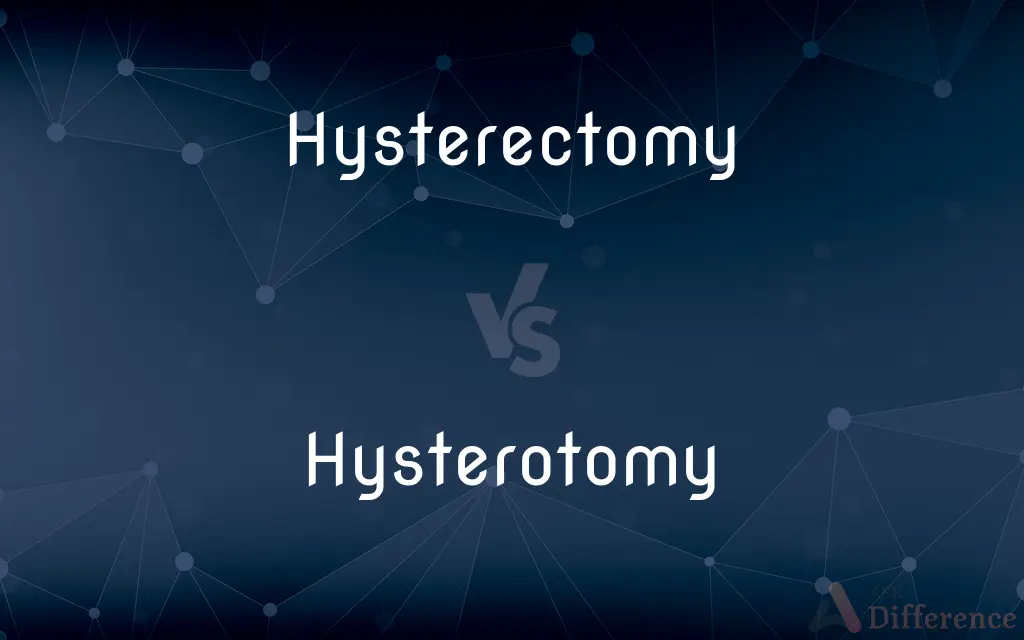Hysterectomy vs. Hysterotomy — What's the Difference?
By Tayyaba Rehman — Updated on October 27, 2023
Hysterectomy refers to the surgical removal of the uterus, while hysterotomy involves making an incision in the uterus, commonly for fetal surgery.

Difference Between Hysterectomy and Hysterotomy
Table of Contents
ADVERTISEMENT
Key Differences
Hysterectomy refers to the surgical removal of the uterus. It can be partial or complete and is often performed for various medical reasons, including uterine fibroids, cancer, or endometriosis. In contrast, hysterotomy involves making an incision into the uterus. This procedure is often done during fetal surgeries or cesarean sections.
During a hysterectomy, the entire uterus or part of it is removed, which can also include the cervix, ovaries, and fallopian tubes depending on the type of hysterectomy. On the other hand, a hysterotomy does not remove any part of the uterus but creates an opening in it. This distinction is critical in understanding the purpose and implications of each procedure.
A hysterectomy is a more invasive procedure and usually results in the loss of reproductive ability. It's considered a permanent solution for certain health issues. In contrast, a hysterotomy is typically performed as part of a temporary intervention, such as delivering a baby via cesarean section, and doesn’t necessarily affect fertility.
Recovery from a hysterectomy is often longer, requiring weeks to months, due to its invasive nature. Conversely, recovery from a hysterotomy may be quicker, as the procedure is generally less invasive, depending on the reason it's performed.
Hysterectomy is a form of sterilization, as it ends menstruation and the ability to carry a pregnancy. Hysterotomy, while it involves surgical intervention on the uterus, doesn't necessarily result in sterilization and is often a component of procedures intended to preserve or support a pregnancy.
ADVERTISEMENT
Comparison Chart
Definition
Removal of the uterus.
Incision into the uterus.
Purpose
Treats uterine problems, cancer, etc.
Often for fetal surgery or C-section.
Impact on Fertility
Usually ends fertility.
Doesn’t necessarily affect fertility.
Recovery Time
Longer recovery period.
Typically shorter recovery.
Invasiveness
More invasive.
Less invasive.
Compare with Definitions
Hysterectomy
Surgical removal of the uterus.
After her hysterectomy, she no longer had menstrual periods.
Hysterotomy
Surgical incision into the uterus.
A hysterotomy was performed during her cesarean section.
Hysterectomy
Medical removal of all or part of the uterus.
A partial hysterectomy saved her ovaries while removing the uterus.
Hysterotomy
An operative procedure involving the uterus.
Her hysterotomy was essential for the fetal surgery.
Hysterectomy
A surgical method for removing the uterine body.
The hysterectomy resolved her chronic pelvic pain.
Hysterotomy
A surgical intervention on the uterus.
The hysterotomy was small and healed quickly.
Hysterectomy
A procedure to treat uterine conditions.
Her doctor recommended a hysterectomy to resolve her severe fibroids.
Hysterotomy
A cut made in the uterine wall.
The hysterotomy allowed doctors to correct the baby’s condition in utero.
Hysterectomy
Operation to remove the womb.
She underwent a hysterectomy to prevent cancer recurrence.
Hysterotomy
Opening of the uterus for surgical purposes.
The doctor carefully made a hysterotomy to access the fetus.
Hysterectomy
Hysterectomy is the surgical removal of the uterus. It may also involve removal of the cervix, ovaries (oophorectomy), Fallopian tubes (salpingectomy), and other surrounding structures.
Hysterotomy
A hysterotomy is an incision in the uterus, and is performed during a caesarean section. Hysterotomies are also performed during fetal surgery, and various gynaecological procedures.In fetal surgery, without inhibition of uterine contractions, premature labor is a complication that occurs in 100% of hysterotomy cases.
Hysterectomy
Surgical removal of part or all of the uterus.
Hysterotomy
Surgical incision of the uterus, as in a cesarean section.
Hysterectomy
(surgery) The surgical procedure to remove all of or part of the uterus.
Hysterotomy
(surgery) The surgical procedure of making an incision in the uterus, commonly combined with a laparotomy during a caesarean section.
Hysterectomy
Surgical removal of the uterus
Hysterotomy
The act of cutting into the uterus, as in Cæsarean section. See under Cæsarean.
Hysterotomy
Surgical incision into the uterus (as in cesarean section)
Common Curiosities
Why would someone have a hysterectomy?
For various reasons, including uterine cancer, fibroids, or endometriosis.
What is a hysterectomy?
It's a surgical procedure to remove the uterus.
Does a hysterectomy affect fertility?
Yes, it ends the ability to conceive or carry a pregnancy.
How long is the recovery from a hysterectomy?
Recovery can take several weeks to months.
Why is a hysterotomy performed?
Often for fetal surgery or cesarean deliveries.
Can you still get pregnant after a hysterotomy?
Yes, it doesn’t necessarily affect fertility.
Are there different types of hysterectomy?
Yes, including total, partial, and radical hysterectomy.
What is a hysterotomy?
It's a surgical incision into the uterus.
Does a hysterotomy remove any part of the uterus?
No, it only involves making an incision.
Is a hysterotomy always related to pregnancy?
Mostly, but it can be part of other uterine surgeries.
Can a hysterectomy affect hormonal balance?
Yes, especially if the ovaries are removed.
Is a hysterectomy considered a form of sterilization?
Yes, it results in sterility.
Is recovery from a hysterotomy usually quicker than hysterectomy?
Generally, yes, depending on the reason for the hysterotomy.
Can a hysterectomy be reversed?
No, it’s a permanent procedure.
Are there alternatives to hysterectomy for treating uterine issues?
Yes, depending on the condition, there can be less invasive options.
Share Your Discovery

Previous Comparison
Enamel vs. Paint
Next Comparison
Gnostic vs. HylicAuthor Spotlight
Written by
Tayyaba RehmanTayyaba Rehman is a distinguished writer, currently serving as a primary contributor to askdifference.com. As a researcher in semantics and etymology, Tayyaba's passion for the complexity of languages and their distinctions has found a perfect home on the platform. Tayyaba delves into the intricacies of language, distinguishing between commonly confused words and phrases, thereby providing clarity for readers worldwide.














































